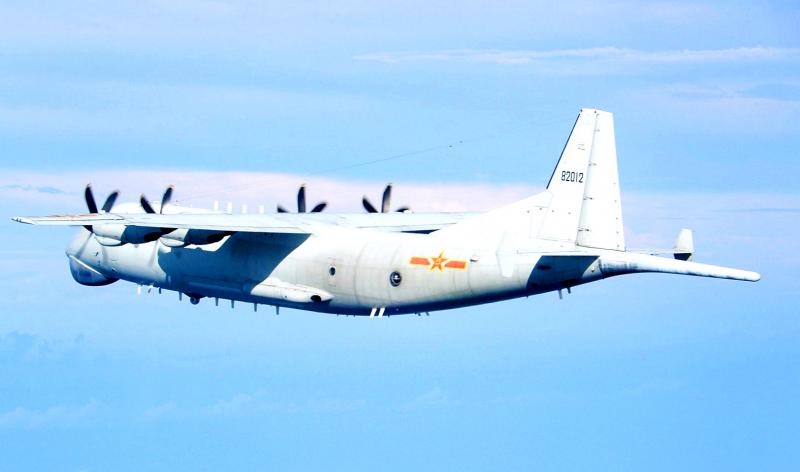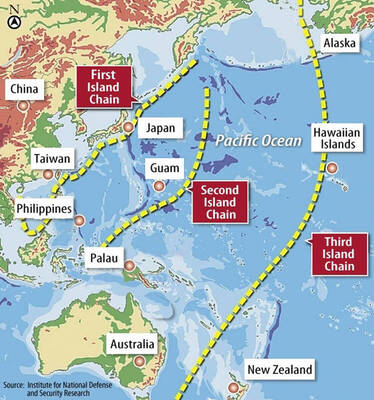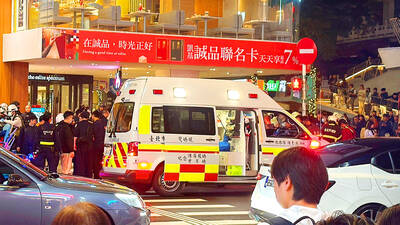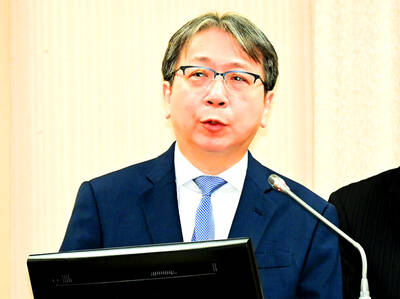A fleet of 19 Chinese military aircraft yesterday morning flew into Taiwan’s airspace in a pincer formation, marking the second consecutive day of such incursions, the Ministry of National Defense said.
Taiwan’s military responded by scrambling jets, issuing radio warnings, and mobilizing surveillance and air defense systems, the ministry said.
The Chinese aircraft fleet comprised 12 J-16 multirole strike fighters, two J-10 lightweight fighters, two J-11 air superiority fighters, two H-6 strategic bombers and a Y-8 transport plane, the ministry said.

Photo: EPA-EFE / Ministry of Defense
A ministry chart showed that the J-10 and J-11 fighters crossed the median line in the northern part of the Taiwan Strait, while the H-6 bombers and the Y-8 plane entered Taiwan’s southwest air defense identification zone.
A pincer movement, also known as a double envelopment, is designed to attack the enemy on two flanks.
Such maneuvers by the Chinese People’s Liberation Army (PLA) are provocative actions that infringe on Taiwan’s sovereignty, the ministry said, urging Beijing to exercise restraint and stop being a “troublemaker” in the region.
On Friday, 18 PLA aircraft entered Taiwan’s airspace, the ministry said.
The incursions coincided with a three-day visit by a US delegation headed by US Undersecretary of State for Economic Growth, Energy and the Environment Keith Krach, who attended a memorial service yesterday for former president Lee Teng-hui (李登輝).
The PLA flights into Taiwanese airspace might be part of a “combat exercise” aimed at intimidating the nation and wearing down its air force, a military source said.
The intrusions on Friday are another example of how China is increasingly using its military to coerce Taiwan, a US Department of Defense spokesman said.
Pentagon spokesman John Supple said that the “aggressive and destabilizing actions” by China’s military reflect “a continued attempt to alter the status quo and rewrite history.”
“This is another example of [China] increasingly using its military as a tool of coercion with Taiwan and other neighbors,” Supple said.
“Taiwan’s security — and its people’s ability to determine their future, free from coercion — remains a vital interest to the United States and is integral to regional security,” he added.
Separately, US Secretary of State Mike Pompeo called the PLA’s actions “military blustering.”
“We sent the delegation to a funeral and the Chinese have apparently responded by military blustering. I’ll leave it at that,” Pompeo told reporters while on a visit to Guyana.
Supple declined to confirm media reports that the US is preparing to approve a large arms sale to Taiwan, saying that the government does not comment on pending arms sales or transfers before formally notifying the US Congress.
CNN on Friday reported that the US is planning to sell seven packages of weapon systems to Taiwan, citing anonymous congressional and administration sources, but said it was unclear when Congress would receive formal notification, as is required by law.
The package is expected to include a large sale of MQ-9B Reaper drones, along with associated equipment and program support, at a value of about US$600 million, said one US official cited in the article.
The most sensitive portion of the proposed package is a long-range air-to-ground missile, the Boeing-made AGM-84H/K SLAM-ER, which could be used by Taiwan’s F-16s, the New York Times reported.
After Reuters on Wednesday broke the news of the potentially imminent sale, the ministry released a statement dismissing the report as “media speculation.”
Taiwan’s military handles arms purchase deals that are under evaluation or being negotiated, based on the principles of confidentiality and discretion, the ministry said, adding that it only publicly reports such deals after the US Department of State has formally notified Congress.
Pursuing seven sales at once is a “rare departure” from years of precedent in which US military sales to Taiwan were “spaced out and carefully calibrated to minimize tensions with Beijing,” the Reuters report said.
Additional reporting by AFP

The US government has signed defense cooperation agreements with Japan and the Philippines to boost the deterrence capabilities of countries in the first island chain, a report by the National Security Bureau (NSB) showed. The main countries on the first island chain include the two nations and Taiwan. The bureau is to present the report at a meeting of the legislature’s Foreign Affairs and National Defense Committee tomorrow. The US military has deployed Typhon missile systems to Japan’s Yamaguchi Prefecture and Zambales province in the Philippines during their joint military exercises. It has also installed NMESIS anti-ship systems in Japan’s Okinawa

TRAGEDY STRIKES TAIPEI: The suspect died after falling off a building after he threw smoke grenades into Taipei Main Station and went on a killing spree in Zhongshan A 27-year-old suspect allegedly threw smoke grenades in Taipei Main Station and then proceeded to Zhongshan MRT Station in a random killing spree that resulted in the death of the suspect and two other civilians, and seven injured, including one in critical condition, as of press time last night. The suspect, identified as a man surnamed Chang Wen (張文), allegedly began the attack at Taipei Main Station, the Taipei Fire Department said, adding that it received a report at 5:24pm that smoke grenades had been thrown in the station. One man in his 50s was rushed to hospital after a cardiac arrest

‘WIN-WIN’: The Philippines, and central and eastern European countries are important potential drone cooperation partners, Minister of Foreign Affairs Lin Chia-lung said Minister of Foreign Affairs Lin Chia-lung (林佳龍) in an interview published yesterday confirmed that there are joint ventures between Taiwan and Poland in the drone industry. Lin made the remark in an exclusive interview with the Chinese-language Liberty Times (the Taipei Times’ sister paper). The government-backed Taiwan Excellence Drone International Business Opportunities Alliance and the Polish Chamber of Unmanned Systems on Wednesday last week signed a memorandum of understanding in Poland to develop a “non-China” supply chain for drones and work together on key technologies. Asked if Taiwan prioritized Poland among central and eastern European countries in drone collaboration, Lin

ON ALERT: Taiwan’s partners would issue warnings if China attempted to use Interpol to target Taiwanese, and the global body has mechanisms to prevent it, an official said China has stationed two to four people specializing in Taiwan affairs at its embassies in several democratic countries to monitor and harass Taiwanese, actions that the host nations would not tolerate, National Security Bureau (NSB) Director-General Tsai Ming-yen (蔡明彥) said yesterday. Tsai made the comments at a meeting of the legislature’s Foreign Affairs and National Defense Committee, which asked him and Minister of National Defense Wellington Koo (顧立雄) to report on potential conflicts in the Taiwan Strait and military preparedness. Democratic Progressive Party (DPP) Legislator Michelle Lin (林楚茵) expressed concern that Beijing has posted personnel from China’s Taiwan Affairs Office to its